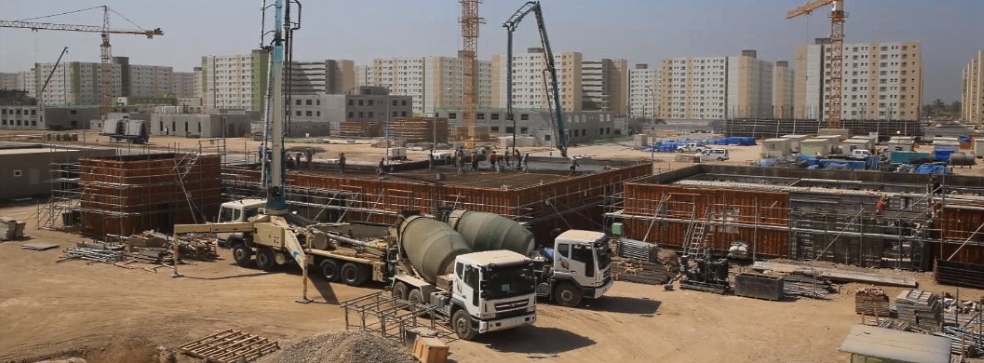To consider an application for financing, fill out the form and send it to us by e-mail along with the project brief, or contact our experts
An industry with more than a century of history has undergone a radical transformation as a result of previous industrial revolutions.
Today it is undergoing new changes as a result of the introduction of digital technologies.
The modern cement industry in the EU, the US and other developed countries is embracing changes such as big data processing, real-time monitoring, smart plants, custom-made concrete products.
In addition, the world is facing global challenges such as environmental degradation, scarcity of natural resources and demographic changes that are affecting the cement industry. At the same time, competition in the global market is intensifying, which creates additional problems for business and requires an immediate increase in efficiency and competitiveness.
This trend is especially pronounced in Europe with its high production costs.
The cement industry remains one of the most energy and capital intensive industries in the modern economy. The most important characteristics of this industry are detailed in the table below.
Table: Key features of the cement industry.
| Features | Short description |
| An important role in the construction sector | Due to the high demand for cement as the main element of concrete, this product is the second most commonly used material in the global construction market. |
| High capital intensity | The construction and modernization of cement plants requires significant investments in the cement industry |
| High energy intensity | The production of 1 ton of cement requires the use of approximately 50 to 130 kg of fossil fuels and 100 kW of electricity |
| Low labor demand | The high degree of automation in modern cement plants helps to reduce production costs significantly |
| Narrow product range | Mass production of products with similar parameters simplifies the organization and management of production processes |
| The international cooperation | The expansion of the cement industry is driven by close collaboration between local and international companies |
| Impact on climate change | CO2 gas emissions require environmentally friendly technologies |
| The need for frequent modernization | Rapid progress explains the high efficiency of modernized cement plants compared to outdated production facilities |
| Transportation cost | High logistics costs when transporting cement, especially by land |
The Covid-19 pandemic has had a negative impact on cement consumption, putting numerous manufacturers in a difficult position.
The sector embarked on a timid recovery from its worst crisis in 2008, but the lockdown canceled all efforts. According to Oficemen, United Kingdom, with its 35 cement plants and a production capacity of about 30 million tons per year, consumed only 13 million tons by the end of 2020.
A catastrophic situation has developed in the cement industry in France, Italy and many other countries in Europe and beyond.
The state of uncertainty calls for caution on the part of investors and lenders, which along with a commitment to innovative technologies will make investments in the cement industry more reliable.
International company SI offers a full range of services for the cement industry, including project finance.
We are ready to attract bank loans, as well as funds from private investors and other sources of funds for your project.
Contact SI consultants to learn more about our services.
Global cement market: before and after the pandemic
According to data published by the International Cement Review 2017, global cement consumption in 2016 reached 4.13 million tons (1.8% annual growth), continuing a gradual recovery from the deep economic crisis.This year, the annual consumption of cement has exceeded 550 kilograms per capita.
China remained the leader in global cement demand, accounting for 58% of global consumption.
Until the Covid-19 pandemic, global cement production has shown steady growth of between 1.5 and 3% per year.
Investment in the cement industry was also booming, supported by infrastructure projects around the world.
North America and South America are traditionally the regions with the highest consumption and production of cement. In 2014, these regions consumed and produced approximately the same amount of this building material (134 and 131 million tons, respectively).
For Central America and the Caribbean, cement consumption and production remains relatively constant, reaching 19-20 million tonnes per year.
With regard to the balance of trade associated with the cement industry, the American continent is considered primarily an importer.
The cement industry in Europe can be divided into three regions based on supply and demand. Firstly, this is Eastern Europe, a rapidly developing region, which accounts for about half of all consumption and production. Secondly, the countries of Western Europe and Southern Europe, which demonstrate a stable level of production and consumption of cement at the level of 70-85 million tons annually. Finally, these are the Nordic countries, which consumed about 26 million tons in 2018.

In terms of trade, the European continent has traditionally been characterized by strong exports of cement products.
Outstanding results were shown by Southern Europe, which in 2017 exported about 20 million tons of cement more than it imported.
The countries of North Africa are leaders on the continent in terms of both consumption and production of cement products. According to ICR, the consumption and production of this building material in the region is fixed at approximately 130 million tons per year.
West Africa kept consumption and production at between 40 and 50 million tonnes, continuing to grow ahead of the Covid-19 pandemic.
The poorest countries in central, eastern and southern Africa remained the least developed in this sense.
Investment in the African cement industry has remained low in recent years, which is why most countries are cement importers. It comes to local customers mainly from cement plants in neighboring Europe and Asia.
In Asia, China is dominant with its capital-intensive industrial and infrastructure projects that require significant amounts of cement. Local plants provide about half of the world's cement production, making China the largest player in the market.
However, in the near future, the cement boom is projected to subside for the first time in four decades.
China's cement production will decline by about 40% between 2015 and 2030, according to the Federation of Inter-American Cement (FICEM).
In terms of export and import, East and Southeast Asian companies are the main exporters all over the world. On the other hand, South and Central Asia are considered cement importing regions.
Finally, the countries of Oceania continue to build cement industry, in which the consumption and production of cement ranges from 10 to 12 million tons per year. This continent is still dependent on cement imports.
Let's go back a few years.
The cement industry experienced its worst recession during the 2008 crisis, after which it began to slowly recover. In fact, experts have estimated the industry's average annual growth at 2%. The unexpected spread of Covid-19, which led to the halt of large business projects, canceled the optimistic forecasts of investors in 2020.
Judging by the current situation, the cement industry is still far from full recovery. Companies are seeing tough times in our sector, urgently requiring unconventional solutions and innovation.
Cement consumption has three main aspects - industrial construction, government infrastructure projects and housing construction. For European countries, more than half of cement consumption in 2018 came from public projects, and only less than a third of cement was consumed by residential construction.
In United Kingdom, the number of building permits for new buildings is expected to decrease by 40% in 2021.
This inevitably means a reduction in the need for materials.
The situation is no better in other large economies in Europe and beyond.
Covid-19, being a global phenomenon, has affected the whole world. Economic scenarios have changed, influencing the plans of investors. The environmental requirements of the Paris Agreement further complicate business.
This requires a revision of the strategies for the production of cement products, the introduction of innovative plans for the development of the industry, and closer interaction between manufacturers and governments.
SI financial experts are ready to be your reliable partner when investing in the cement industry.
Contact us at any time to find out more.
The future of the cement industry: what investors and lenders should consider
Like other industries, the cement sector is actively developing and strives to become a self-organizing sector in a smart ecosystem.Linear processes and isolated functions are transformed into interconnected clusters that exchange information in real time. The main driving forces behind this change are digitalization and information technology.
This applies to all participants in the value chain. However, the transformation of the industry towards a smart ecosystem will be gradual. The transition to the digital economy has just begun, and for now, businesses with different value creation models must coexist.
Raw materials
In the future, information on raw materials for the cement industry will be available to plants in real time, including the quantity, status of limestone and clay reserves in the quarries.Quarries must inform cement plants about the reserves and quality of minerals, or give appropriate signals otherwise. This information will be communicated to all nodes in the value chain in real time, and as a result, the enterprises involved will quickly adapt.
Suppliers
Suppliers of materials, services, equipment, fuels and raw materials used in the production of all types of cements can communicate with customers and manufacturers in real time and thus respond almost immediately to their requests.Modern enterprises are also able to control the production process of the corresponding cements, making an accurate forecast of consumption and stocks of finished products.
Digital technology allows companies to increase or decrease inventory on time and resolve potential quality issues.
Continuous communication allows suppliers to optimize their supply without impacting the production of custom or high value-added cement. The supplier can work with the manufacturer to create recommendations for improving the quality of the final product by analyzing demand and predicting future customer requirements.

Operation and maintenance
At various stages of production, the involved cement plants will be able to carry out most of their tasks with limited or more specific human intervention.Many of the functions and tasks for the operation and maintenance of cement plants can be centralized, making them proactive and more efficient.
Production will be optimized based on historical and up-to-date supply and demand information, providing full visibility into production capacity, costs and customer needs. Thanks to investments in computer technology, new algorithms are being introduced today to improve cement production.
Digitalization will improve equipment maintenance through remote control.
Thus, the practice of reactive maintenance will give way to statistical analysis of reliability and forecasting of failures, which will reduce equipment downtime and minimize business losses.
Logistics
Logistics in the cement industry could be more flexible if it was based on real-time order information.The result is better capacity allocation, faster and more accurate shipments, and therefore fewer rejections.
In addition, route planning can be improved by analyzing information in real time about the conditions for receiving and unloading goods. This requires the use of computer technology and additional investment in the training of logistics managers and other responsible personnel.
Clients
The effectiveness of investments and loans in the cement industry depends on the quality of interaction with customers.Customers are an integral part of the smart ecosystem of the cement industry, as well as the last link in the value chain and the driving force behind the modern business model.
By the broad term “customers” we mean consumers, institutions, universities, associations and other private or public entities who buy, use, research, promote, standardize, innovate and make important decisions in the cement industry.
With innovative technical solutions, customers can access real-time supply and demand information.
Direct communication between end users, manufacturers and distributors of cement will allow better planning and fulfillment of orders with specified requirements. Active interaction between the parties will allow those responsible for all parts of the value chain to make the right strategic decisions.
It is important for investors to understand the importance of digital technology to the cement industry.
What is a priority, even at the initial stages of the sector's transformation, is to make the customer the central link in the value chain, that is, the epicenter of the future smart ecosystem.
The rest of the ecosystem will be centered around customer-centric manufacturing, including raw materials, suppliers, manufacturing, service and logistics.
Investment in cement plants: loans and services
SI is an international company offering financial, engineering and legal services for the cement industry in Europe and beyond.Our team is ready to develop customized financial models and lending solutions for financing the construction of cement plants, quarrying, etc.
We also offer direct investments in the cement industry, including lending and construction, expansion or modernization of existing facilities.
Our project finance schemes with a proponent's contribution of 10% help companies to bring ambitious projects to life.
SI with its partners provides a full range of engineering services.
We are ready to act as a general contractor for the construction of cement plants under an EPC contract. Advanced technical solutions are used by dozens of customers in Europe, Asia, Middle East, Africa, South America.
The geography of our services is constantly expanding, allowing us to use new experience for your projects.
Contact us to find out more.




